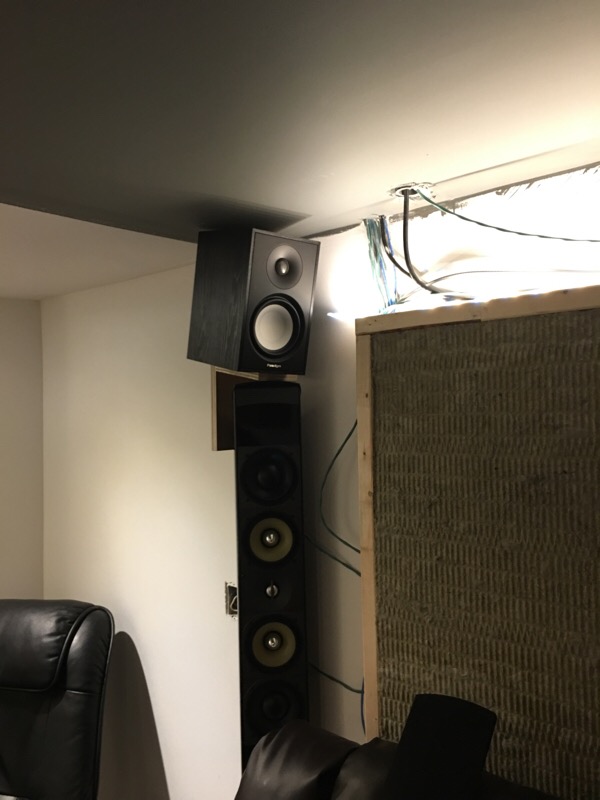From the Dolby Atmos website. I think the makers know better than a random guy who still lives in her mom's basement. Seriously guys, there is not debate, you can't go against the makers of the technology....
I don't live in my mom's basement. Grew up in a house without a basement...

So I guess that puts me at a slight advantage...?

"Will I always get better Dolby Atmos sound with overhead speakers?
Dolby Atmos enabled speakers produce slightly diffuse overhead audio that is quite lifelike and, in some cases, preferable to the sound that comes from overhead speakers."
"Audio experts agree that the overhead layer of sound produced by Dolby Atmos enabled speakers can be preferable to the sound originating from overhead speakers."
(Emphasis above mine.) Always and Some / Can and Is - pretty significant differences. My interpretation of those statements is that bouncing speakers will
less often deliver a preferable experience than overheads, but anything is possible and you are free to make your own interpretations of course...
Also, from the Dolby site: "
Ceiling speakers and Dolby Atmos enabled speakers (or modules) deliver equivalent performance." So, it would seem Dolby might be somewhat contradicting itself...hmmm...
"Dolby Atmos enabled speakers do not rely on virtualized processing. That means you don’t have to sit in a specific spot to get the full Dolby Atmos effect."
"Based on an understanding of how the brain interprets sound, Dolby Atmos enabled speakers modify select audio frequencies to reinforce the sense of sound coming from above. This filtering is also applied to any sound that may leak horizontally from the speaker cabinet to further amplify the perception of sound coming from above."
You can't simply place a DAE speaker anywhere in a room and have it work properly and you do have to have the appropriate surfaces (ceiling), and circumstances for this to be successful, as many here will attest. Ceilings speakers of course have their own drawbacks, nobody will argue that, but that is largely a cost/architecture issue, not performance. DAEs can compensate for that, but aren't a magic bullet either for a sub-optimal space.
So basically, unless you have incredibly tall ceilings like in theaters, you're not only wasting your money in overhead speakers, but getting worse results.
A tilted speaker, is not a Dolby Atmos enabled speaker either as many said. You want Atmos at home, get a Dolby Atmos enabled speaker.
Sure, a simply tilted speaker may not be a Dolby Atmos Enabled speaker, does not mean it's automatically bad or won't work. But I do wonder how those specifically Dolby Atmos Enabled speakers work with other immersive formats as compared to in-ceilings? Dunno, maybe they're awesome and work exactly the same....

But it seems like they are engineered, well, for Dolby Atmos, not DTS:X or Auro 3D whereas a ceiling speaker might be more generic and work better?
You and your huge massive subwoofer, receiver and speakers are getting worse sound for movies with your 10 feet ceiling, than the guy that buys a Vizio 5.1.4 soundbar. Hard to digest, but the true.
How do prove such a thing? I only have 8ft. ceilings, but I'm going to argue that I'm getting better than a soundbar....

Soundbars, while improving, are in my opinion work-arounds for those that can not or do not want to afford, or perhaps lack the space or motivation to install, larger systems. Maybe they are the best kept secret since, well, dunno....lemme guess, you're one of the soundbar guys!? I'd certainly take one given no other option, but not my first choice.
Bigger is not better, speakers are speakers, for decades the same technology, surround-sound processing matters. You can get way better sound from a particular surround-sound processing code, than from expending thousands in useless over-sized speakers.
There might be over-sized, but there are also right-sized, and undersized drivers/speakers. Yes - bigger can be better (especially in the case of subwoofers), and maybe smaller can be better too. You analyze the space vs. preferences and limitations of course to address this. Physics is still physics and any design must adhere to those laws to define its capabilities within a given space.
Of course, hi-fi dinosaurs freaks would tell you the opposite, because they paid thousands for their crappy set up, good for music only....
Most of you are watching movies in small rooms, stop wasting your money...
Of course, you might not need to spend a fortune to get a good experience. And while I'm no hi-fi dinosaur or audiophile, I did pay thousands for what I would call a good set up. Trust me - it's a pretty good set up for music and home theater. (well, living room entertainment, I don't have a dedicated theater room...

) Sure, DAE speakers can work, and might be better than nothing, but I don't think you're convincing anybody that they are superior. Lotta pretty experienced people here that are simply going to disagree - people with incredible set ups, knowledge, and experience beyond my wildest dreams. I've gotta give the nod to them. They may not be "watching movies in small rooms", but that does not mean their experiences and knowledge can't be applied to lesser spaces.


/svs-prime-elevation-speaker-1500aaa-56873d0e3df78ccc15096ee0.jpg)




